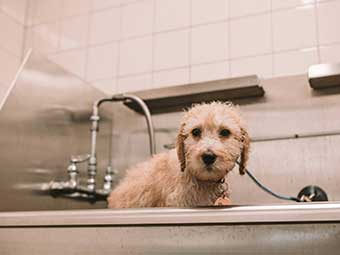How Often and How to Bathe a Dog Properly? A Step-by-Step Guide
Dog Bathing Frequency: Tips for a Clean and Healthy Pup
Reading time : 1 minute,
Discovery Chepe Id-664-VID
Published in
04-11-2025

Photo: @azucenavil
Bathing a dog properly is an essential part of their hygiene and overall well-being. However, the frequency and method can vary depending on their breed, coat type, activity level, and skin health. Below is everything you need to know to keep your furry friend clean and happy.
How often should you bathe a dog?
Every 4 to 6 weeks: is a good general rule for most domestic dogs.
Long-haired dogs: such as Golden Retrievers or Collies, should be bathed every 3 to 4 weeks.
Short-haired dogs: like Beagles or Dobermans, can go 1 to 2 months between baths.
Dogs with sensitive skin or dermatological conditions: need special shampoos and a schedule tailored by a veterinarian.
Very active or frequently dirty dogs: if your dog often plays in mud, the beach, or fields, they may need more frequent baths.

Best Practices for Washing Your Dog: Step-by-Step
Photo: Kristin Brown
How should you bathe a dog?
Brush before the bath: this removes knots, surface dirt, and loose hair.
Use lukewarm water: avoid cold or very hot water, as it can cause discomfort or stress.
Use a dog-specific shampoo: never use human shampoo, as a dog's skin has a different pH balance.
Protect the eyes and ears: avoid getting water in these sensitive areas. You can place a cotton ball at the ear's opening, without inserting it deeply.
Rinse thoroughly: shampoo residue can cause itching or allergic reactions.
Dry the dog well: first with a towel and then with a low-heat dryer if your dog tolerates it.
Brush again after drying: especially if your dog has long or thick fur.
Common mistakes when bathing a dog
Bathing too frequently: this can strip away natural oils that protect the skin.
Using inappropriate products: human shampoos or scented soaps can upset the dog's pH balance.
Not drying properly: moisture, especially in skin folds, can lead to fungus or infections.
Not getting the dog used to bathing as a puppy: this can cause fear or resistance in adulthood.
A well-done bath not only keeps your dog clean, it also strengthens your bond and helps you detect any skin or coat issues early.
Bathing your dog doesn't have to be complicated. With the right frequency, proper products, and a little patience, your pet will look and feel great. Always watch their behavior and consult your vet if you have any doubts about their hygiene or skin health.
See Also
Discovery Chepe
Most read...














